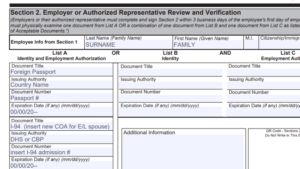- within Antitrust/Competition Law topic(s)
- with readers working within the Banking & Credit and Telecomms industries
During this challenging time for employers in search of workers, U.S. Customs and Border Protection (CBP) and U.S. Citizenship and Immigration Services (USCIS) have managed to cooperate to coordinate a response to the litigation settlement (Settlement) reached in Shergill, et. al. v. Mayorkas announced on November 12, 2021. The Settlement will finally recognize that spouses of L-1 intracompany transferees (L-2) and E-1/E-2/E-3 nonimmigrant visa holders are authorized to work "incident to their status" as spouses of these principal nonimmigrants. This article is limited in scope to the E and L dependent spouses affected.
More recently, on January 31, 2022, CBP's Systems Enforcement Analysis and Review (SEAR) office confirmed that CBP was applying the following new admission codes to identify spouses of E and L principals for documentation of work authorization.
What are the new approved Category of Admission (COA) codes related to the Settlement being used by CBP?
E-1S – Spouse of E-1
E-1Y – Child of E-1
E-2S – Spouse of E-2
E-2Y – Child of E-2
E-3S – Spouse of E-3
E-3Y – Child of E-3
L-2S – Spouse of L-1A or B
L-2Y – Child of L-1A or B
Please note that USCIS is also using these codes when approving a change or extension concerning L or E dependent status, which is stated on the I-94 placed at the bottom of the I-797 approval notice. These codes will only be applied to new arrivals to the U.S. by CBP.
If I am an E or L nonimmigrant spouse in the U.S. without this annotated I-94 with the new code, how do I get an I-94 with the code?
SEAR officials confirmed that for those requiring an I-94 with the new code, they would have to depart the U.S. and reenter to request the new I-94. Those using the option of automatic revalidation to reenter the U.S. after a trip of 30 days or less to Mexico or Canada will receive an I-94 electronic admission record with the code via CBP's online I-94 website. If, for some reason, at the land border, a paper I-94 admission record is issued, the same codes will be used. CBP recommended that E and L nonimmigrant spouses carry proof of marriage to the principal E or L nonimmigrant at time of applicant for entry to the U.S.
Are these annotations necessary for Form I-9 completion as to work authorization?
Good question. USCIS posted changes to Volume 10, Chapter 2 of its policy manual (PM) related to the Settlement. The PM notes that, " As of November 12, 2021, USCIS considers E-1, E-2, E-3 and L-2 dependent spouses employment authorized incident to status."
This PM change also specifies that a Form I-94 solely notated with the following types of nonimmigrant statuses: "E-1," "E-2," "E-2C," "E-3," "E-3D," "E-3R," or "L-2," IS NOT SUFFICIENT to serve as evidence of employment authorization.
The M-274 Handbook for Employers for Form I-9 completion was updated on November 16, 2021, regarding the Settlement, but this update was done before the creation of the COA codes noted and focused on the automatic extension of work authorization part of the Settlement described below. We obviously need these COA codes addressed by USCIS as to the Form I-9 and E-Verify sections of the USCIS website.
How do employers typically complete a Form I-9 for E and L nonimmigrants?
When an L-1, E-1, E-2, or E-3 nonimmigrant selects documents from List A, or B and C to present for Form I-9 completion, they will normally present their I-94 admission record and passport to constitute a List A acceptable combination. For dependent spouses, their work authorization eligibility will not be limited to a specific employer as required for their associated nonimmigrant principals holding E or L status. We should expect that E and L spouses will also typically present this combination (Passport and I-94 with new code). Note that this scenario shifts from the employer's perspective from typically seeing an Employment Authorization Document (EAD) (card) for work authorization. So, this change eliminates the long delays to process an EAD by USCIS for these E and L nonimmigrant spouses. Of course, their I-94 will be limited to the validity of their principal E and L nonimmigrant spouse. In addition, the need to address the automatic extension of EAD validity noted in the Settlement will be rare in the future, except perhaps for those unable to obtain a new I-94 with the appropriate code annotation.

As background, what were the major developments referenced in the Settlement?
- USCIS agreed to issue policy guidance stating that L-2 spouses are authorized to work based on their status as L-2 nonimmigrants without the need to apply for an employment authorization document (EAD). This development was really HUGE. Why? Well, USCIS is severely backlogged as to the adjudication of I-765 work authorization applications for EADs. Right now, applicants can wait for 8 to 13.5 months or longer for approval. The trick here is that employers must be advised regarding what documents are acceptable to prove L-2 status. So, USCIS and CBP were working to achieve within 120 days of November 10, 2021 (the "Effective Date" of the Settlement), an annotation on the I-94 admission record to be presented for List A/C work authorization purposes for Form I-9 The deadline created for this development was March 10, 2022. As noted above, CBP released its COA changes on January 31, 2022, ahead of the deadline.
- In addition, USCIS agreed to provide that automatic extensions of work authorization will apply to L-2 nonimmigrants under 8 CFR §274a.13(d), who file their I-765 applications before their EAD expires to allow for continuation of work authorization for up to 180 days. The problem here is that the automatic extension is cut short by the expiration of the I-94 admission period. For example, an employer must reverify the employee's work authorization at the earlier end date on I-94, the date the I-765 application is approved or denied, or the end of the 180 day EAD auto-extension period. This situation leaves the employer with a very difficult predicament to address, juggling these three factors. On November 30, 2021, USCIS posted a clarification of this change for Form I-9 completion. In this posting, USCIS noted that both E and L-2 spouses are now considered employment authorized incident to status, but that the documentation issued by USCIS for the categories remains the same.
After the Settlement was announced by USCIS on November 12, 2021, USCIS issued a related Policy Alert to clarify that both E or L dependent spouses will qualify for the automatic extension of work authorization (as limited in time as noted above) by a timely filing of an extension application (I-765) before the EAD expires. In this Policy Alert, USCIS stated that the necessary combination of documents required to support the application of the automatic extension is:
- Form I-94 indicating the unexpired nonimmigrant status (H-4 or E or L dependent spouse);
- Form I-797C receipt notice for a timely filed EAD renewal application (Form I-765) stating "Class Requested" as (a)(17), (a)(18), or (c)(26), as applicable; and
- Facially expired EAD issued in the same category (A17, A18, or C26).
In addition, the Policy Alert confirmed that E and L dependent spouses are employment authorized incident to their status; and, "therefore they are no longer required to request employment authorization by filing Form I-765 but may continue to file Form I-765 if they choose to receive an EAD."
Wait a minute!! What did USCIS mean – "if they choose to receive an EAD"?
Well, until USCIS and CBP updated their requirements as to acceptable documents to present for work authorization regarding E and L-2 spouses, an EAD would still be necessary with its long delays for the adjudication of the I-765 for Form I-9 completion. Of course, as of January 31, 2022, E and L dependents already in the U.S. have options to obtain a new I-94 with the appropriate category code via reentry to the U.S. or even via an I-539 extension if necessary. For those E and L spouses entering the U.S. on or after January 31, 2022, their I-94 should have the appropriate code.
What about spouses already admitted to the U.S. without this new code on their I-94 applying for an I-94 code reference via deferred inspections?
Some attorneys are reporting that CBP may be willing to make the code change within the I-94 system via request to a CBP deferred inspections office, but this option was noted as not available by SEARS. CBP normally corrects "errors" via access to a deferred inspection office, not to address new category codes which did not exist at the time of the issuance of the I-94 record. So, as noted above, it may be that a solution for some spouses in the U.S. will be departures to Mexico or Canada and requests for readmission to generate an I-94 with the appropriate code. Admission to the U.S. is never a guaranteed situation. USCIS could, of course, also implement an interim solution to allow a marriage certificate and valid I-94 record in L-2 or E status to suffice for work authorization in the interim for spouses in the U.S. as to List C for Form I-9 purposes; but so far, we have no indication of this potential alternative being allowed.
Key Take Aways – Spousal Work Mobility
E-1, E-2, E-3, and L-2 spouses will be able to seek employment upon admission to the U.S. and must carefully check the code on their I-94 record, which will be the key to their documentation of work authorization to an employer or for self-employment for that matter. As to labor shortages, employers desperate for help will have a new pool of available workers much faster and without the bureaucratic delay of the adjudication of an EAD application. For those international companies trying to move international talent to the U.S. temporarily, spousal work authorization as a benefit is a major consideration as well for many recruits/foreign employees to take assignments. It seems USCIS and CBP are doing something that makes absolute sense.
The content of this article is intended to provide a general guide to the subject matter. Specialist advice should be sought about your specific circumstances.

